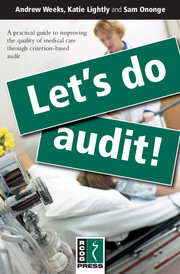 Let's Do Audit!
Let's Do Audit! Book contents
- Frontmatter
- Contents
- Acknowledgements
- Introduction
- Lesson 1 An introduction to clinical audit
- Lesson 2 Problem identification
- Lesson 3 Setting standards and establishing criteria
- Lesson 4 Measuring current practice
- Lesson 5 Analysing the data and comparing practice with agreed criteria
- Lesson 6 Implement change and re-audit
- Conclusion – let's do audit!
- References
- Appendix. Worked examples of audits
- Glossary of terms
- Index
Lesson 4 - Measuring current practice
Published online by Cambridge University Press: 05 July 2014
- Frontmatter
- Contents
- Acknowledgements
- Introduction
- Lesson 1 An introduction to clinical audit
- Lesson 2 Problem identification
- Lesson 3 Setting standards and establishing criteria
- Lesson 4 Measuring current practice
- Lesson 5 Analysing the data and comparing practice with agreed criteria
- Lesson 6 Implement change and re-audit
- Conclusion – let's do audit!
- References
- Appendix. Worked examples of audits
- Glossary of terms
- Index
Summary
Having established criteria against which practice will be assessed, the next step is to observe current practice and to collect the raw audit data. To do this, you first have to work out what you actually want to know, from how many patients and how it is best to go about getting this information. It is then best to do a short pilot: collect the data on a few cases and then reassess your process to see if it works and is not too difficult or time consuming. You can then amend your plan and proceed to collect the rest of the data.
Step 1 – Work out what you need to know
There are three main sorts of data that you will need to collect: basic information, audit criteria and other relevant points.
Basic information
In most audits (but not all), basic demographic details are collected. This is done so that you can assess whether the group you are studying is representative of the whole population. The basic patient identifiers are sex, age and patient identification number. These may be collected initially to enable data from various sources to be combined. It also helps if you need to go back and find the patient again to get missing data. But remember that specific identifiers (date of birth, hospital number) should be removed from the final data so that the information is made anonymous.
Information
- Type
- Chapter
- Information
- Let's Do Audit!A Practical Guide to Improving the Quality of Medical Care through Criterion-Based Audit, pp. 27 - 36Publisher: Cambridge University PressPrint publication year: 2010